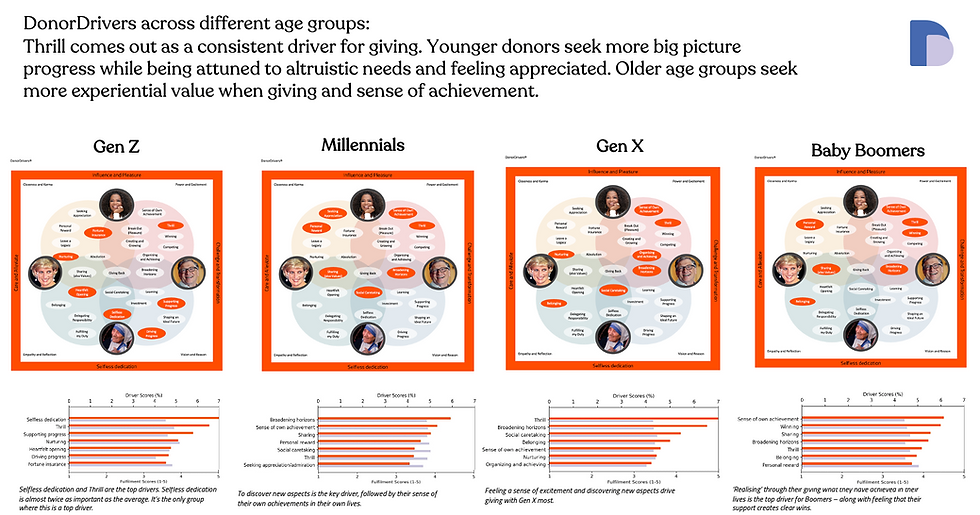Reframing Giving: What Motivates Australian Donors and How NFPs Can Respond
- Denice Diaz
- Jul 1
- 3 min read
Understanding what truly motivates individuals to give presents an opportunity for not-for-profits (NFPs) to strengthen their differentiation with other organisations and strengthen supporter relationships. New insights from the DonorDrivers® study reveal that increasing fundraising effectiveness starts with a deeper understanding of the psychological needs that inspire people to give.
A Mixed Motivational Profile: Experiential and Altruistic
Australian donors are motivated by a unique blend of self-directed and other-directed needs, with the data showing an even split between experiential and altruistic drivers.
While many give out of a desire to help others, they’re also motivated by personal meaning—whether that’s learning something new, feeling the thrill of contribution, or gaining a sense of personal achievement. These experiential drivers are just as powerful as traditional altruistic motivations.

This mix of motivations opens up new possibilities for NFPs to engage more meaningfully. Many donors are still seeking organisations that fully reflect what they value most—creating a clear opportunity for those willing to evolve how they connect, communicate, and build relationships.
Donor Motivations Are Nuanced—and Valuable to Understand
One-size-fits-all messaging no longer resonates. Our research shows meaningful variations in donor motivations across gender, age, and income groups:
Men often prioritise self-directed motivations like thrill and achievement.
Women are more likely to value relational and altruistic drivers.
Younger donors want to see progress on big-picture issues—but also want to feel emotionally fulfilled and appreciated for their role.
Across all income levels, a sense of personal achievement remains a consistent top driver.

These distinctions are not challenges—they're opportunities for smarter donor segmentation and tailored, personalised donor journeys that reflect what truly matters to different supporter groups.
A Global Comparison: Australian Donors Stand Apart
When compared with Dutch donors, key differences emerged. While thrill is the leading driver among Dutch donors, Australian donors place greater value on broadening their horizons.

Even within Australia, motivations shift by cause. For example, donors who support overseas aid are more likely to seek emotional satisfaction and excitement from their giving compared to donors more broadly.
These insights reinforce the importance of context when designing donor experiences—whether by geography, cause area, or donor profile.
Embedding DonorDrivers® in Your Strategy
NFPs now have the ability to move beyond assumptions and dig into what truly drives their own supporters. By embedding the DonorDrivers® module into surveys or supporter research, organisations can gain deeper clarity on:
Which psychological drivers are most relevant to their audience
How well current efforts are fulfilling those needs
What specific opportunities exist to enhance messaging, stewardship, and engagement
Used in over 40 countries, DonorDrivers® gives NFPs the evidence they need to act with confidence. It’s a proven way to uncover insights that inform strategy—not just measure satisfaction.
Learn more about DonorDrivers® and how you can use it to further improve your fundraising effectiveness.
Fulfilling More of What Matters
Australian NFPs are already making progress in meeting donor expectations—and the potential to go further is significant. As organisations deepen their understanding of donor needs and motivations, they unlock new ways to build stronger connections and long-term supporter loyalty.

Taking a more strategic, insight-led approach to donor engagement means going beyond demographic data to tap into what truly drives giving. This includes:
Crafting messaging that speaks to impact, personal value, and emotional connection
Designing supporter journeys that fulfil both altruistic and experiential motivations
Building trust by addressing key concerns—such as transparency and respectful communication
Looking Ahead: Smarter, More Meaningful Fundraising
With Australians donating to an average of 2.6 charities each year, and many giving modest amounts, standing out requires more than a compelling mission—it requires relevance and resonance.
By leveraging behavioral insight, embracing tailored engagement, and aligning more closely with the full spectrum of donor motivations, today’s NFPs have a clear opportunity to lead the way in increasing fundraising effectiveness.
The future of giving isn’t about doing more—it’s about understanding more. And those that do will be better positioned to build the trust, loyalty, and support they need to thrive.


Comments